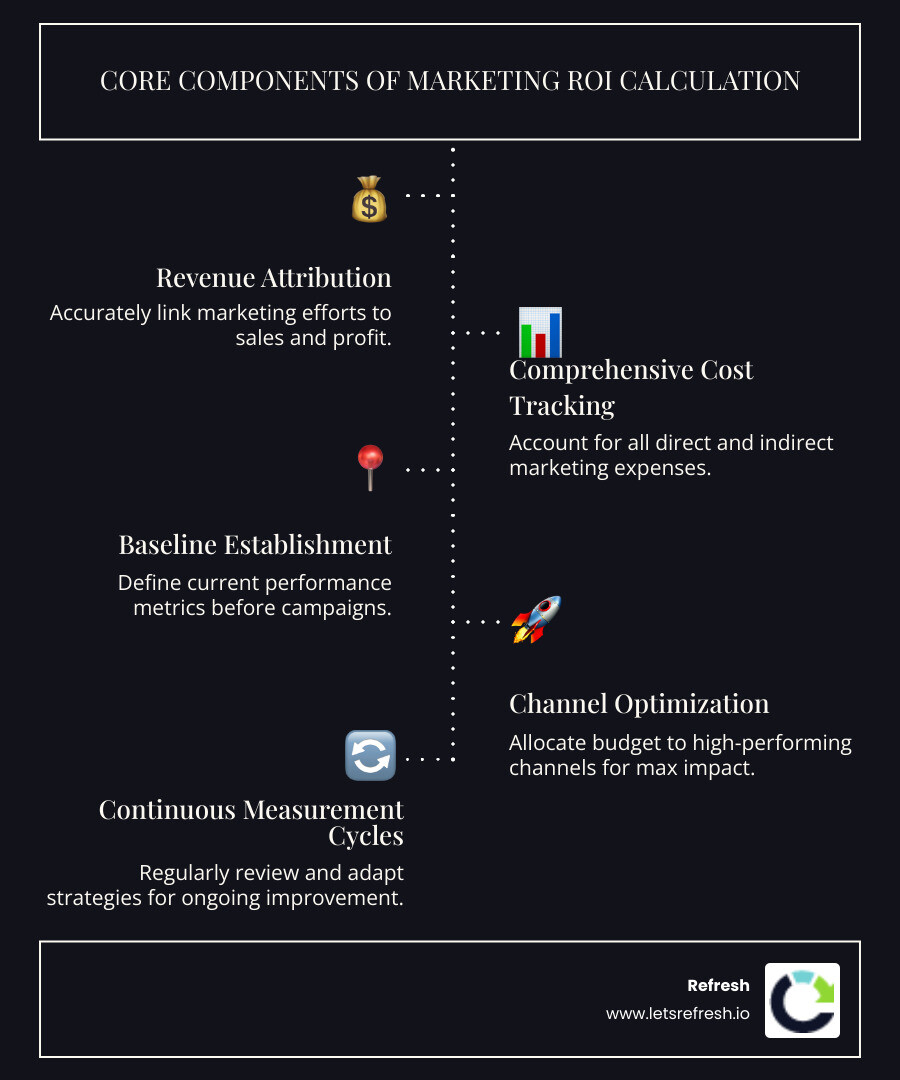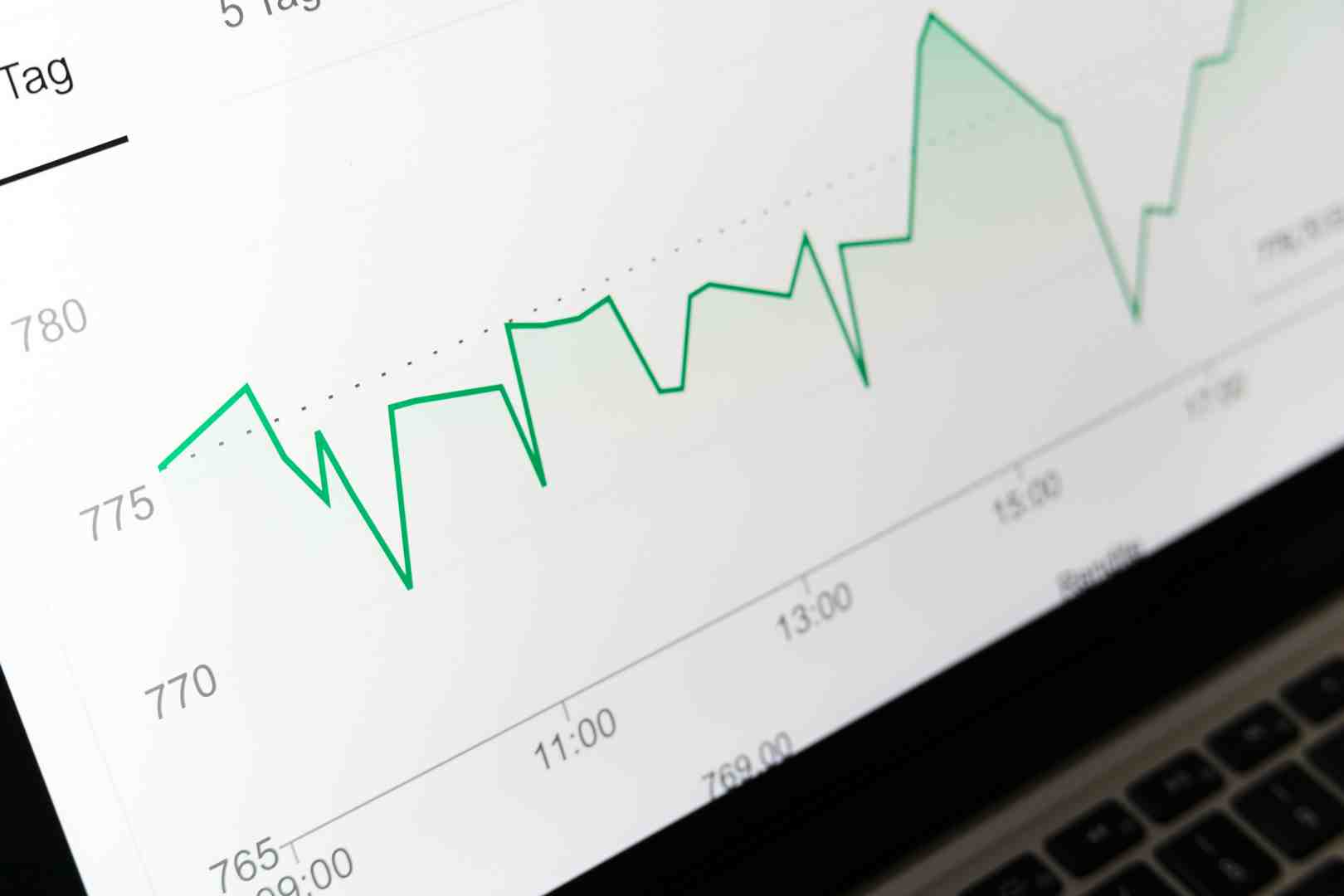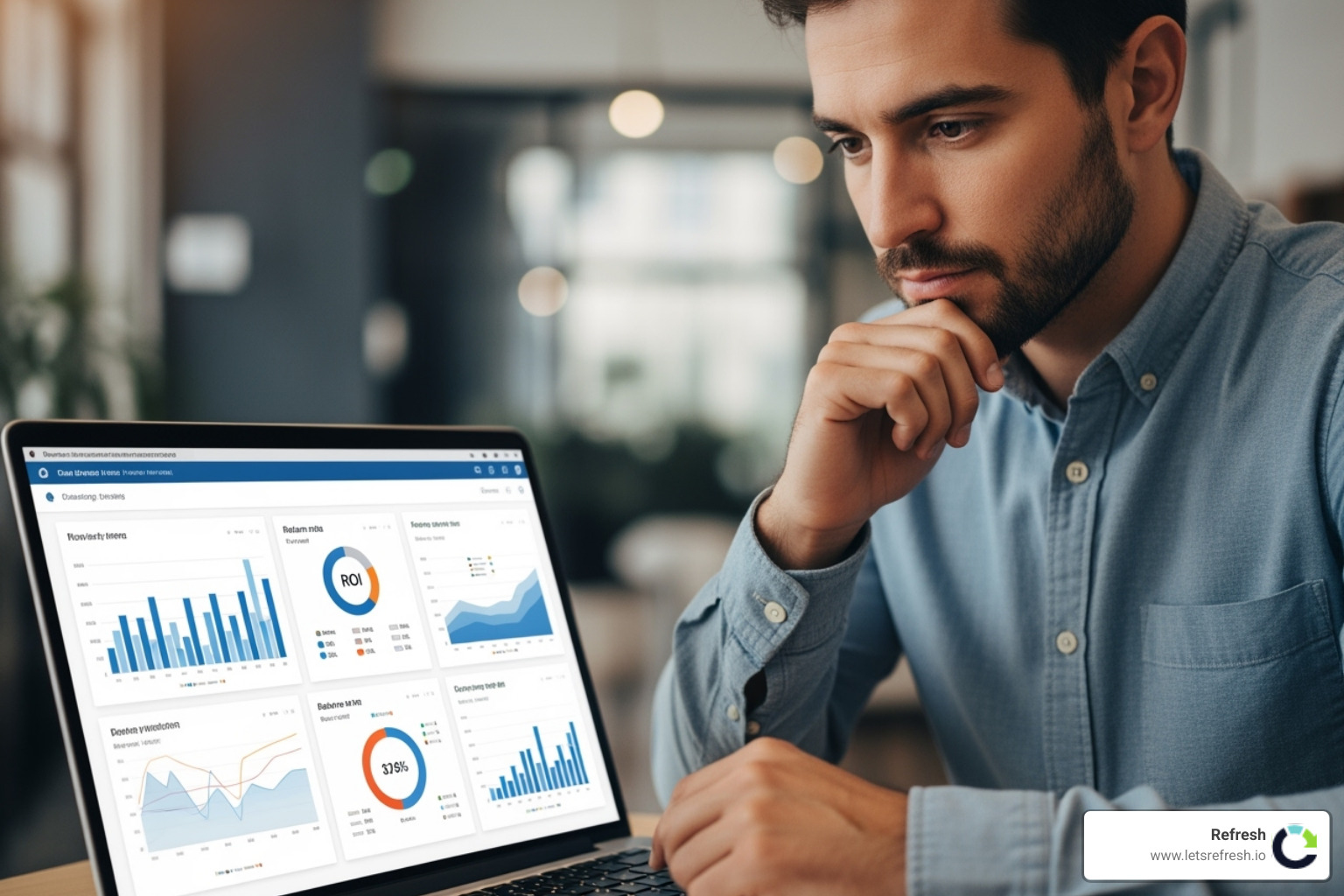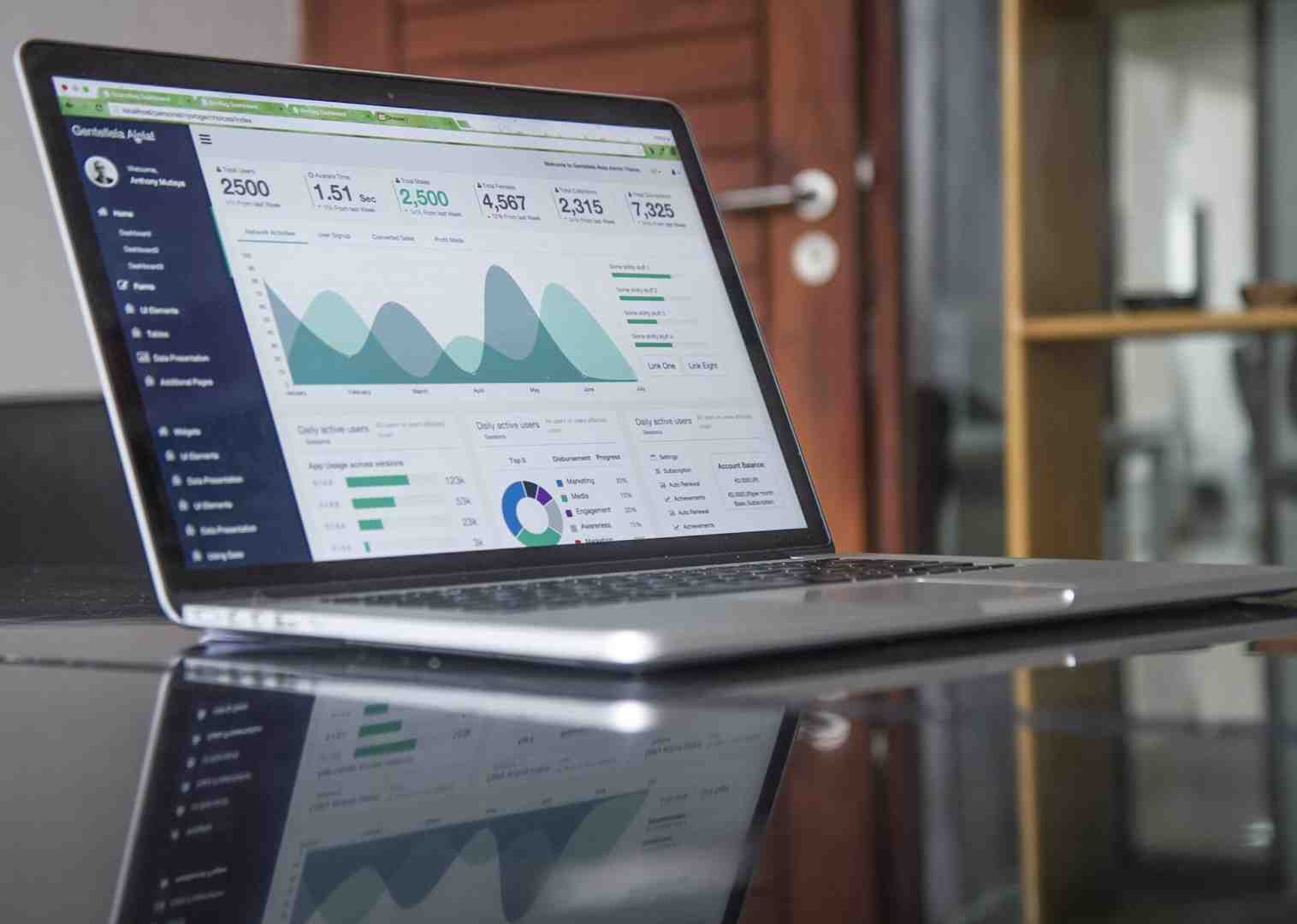October 14, 2025
Why Marketing ROI Matters More Than Ever
Maximize marketing ROI has become the critical metric that separates thriving businesses from those burning through budgets without results. In today's competitive landscape, every marketing dollar must work harder and deliver measurable returns.
Quick Ways to Maximize Marketing ROI:
- Calculate accurately - Include all marketing costs, not just ad spend
- Track key metrics - Focus on Customer Acquisition Cost (CAC) and Customer Lifetime Value (CLV)
- Optimize high-performers - Double down on channels delivering the best returns
- Use data wisely - Set baselines and eliminate underperforming tactics
- Leverage automation - Use AI and tools to reduce waste and improve targeting
The stakes couldn't be higher. Research shows that marketers who measure ROI are 1.6 times more likely to receive higher budgets, while over 40% of marketers feel their current budget is misallocated. This means businesses that master ROI measurement gain a significant competitive advantage in securing resources and proving marketing's value to stakeholders.
Yet many growth-stage companies struggle with outdated tracking methods, complex customer journeys, and the challenge of connecting marketing activities to actual revenue. The good news? Modern tools and proven strategies can transform your marketing from a cost center into a profit-driving engine.
At Refresh, we've developed over 200 websites and helped numerous businesses establish strong digital footprints. We've seen how the right approach can maximize marketing ROI and drive sustainable growth. In this guide, we'll walk through the exact strategies and tools that turn marketing investments into measurable business results.

The Foundation: Calculating and Tracking Marketing ROI
At its core, marketing ROI asks one simple question: are we making more money than we're spending? While the concept is simple, getting an accurate answer can be tricky.
Marketing ROI is your financial compass. It shows you which campaigns are profitable and which are underperforming. Without it, you're essentially guessing where to allocate your budget and hoping for the best.
The basic formula looks deceivingly simple:
Marketing ROI = (Revenue Generated - Marketing Cost) / Marketing Cost
Let's say you spend $10,000 on a campaign and it brings in $50,000. Your ROI would be ($50,000 - $10,000) / $10,000 = 4, or 400%. For every dollar you invested, you got four back.
But here's where most people mess up - they only count the obvious costs. Comprehensive marketing costs include everything: your team's salaries, software subscriptions, creative production, third-party fees, and even that fancy analytics tool you forgot about. Missing these hidden costs can make your ROI look way better than it actually is.
There's another wrinkle too. Your business probably grows naturally over time, even without marketing. This organic sales growth means you can't give your campaign credit for every single sale. You need to measure the incremental lift - the extra revenue that came specifically from your marketing efforts.
So what's a good marketing ROI? A 5:1 ratio is considered strong, while 10:1 is exceptional. However, these benchmarks vary wildly by industry and business model. The best approach is to establish your own baseline and focus on continuous improvement. If you're looking for comprehensive support, our Small Business Digital Solutions can help you build this foundation properly.
Key Metrics and KPIs for Success
Once you've got the basics down, you need the right metrics to guide your decisions. Think of these as your marketing dashboard—the gauges that tell you if your engine is running smoothly or about to stall.

Customer Acquisition Cost (CAC) tells you exactly how much you're spending to win each new customer. If this number keeps climbing, something's wrong with your funnel. Customer Lifetime Value (CLV) shows how much revenue each customer brings over their entire relationship with you. The magic happens when your CLV is significantly higher than your CAC.
Conversion rates might be the most telling metric of all. They show what percentage of people take action after seeing your marketing. It's no wonder that one in three marketers cite conversion rates as their top KPI—it's the difference between traffic that pays the bills and traffic that just looks pretty in your analytics.
Return on Ad Spend (ROAS) gives you a laser focus on your advertising performance specifically, while Marketing Efficiency Ratio (MER) provides the big picture view by dividing your total revenue by total marketing spend for any given period.
These metrics work together to paint a complete picture of your marketing performance. When you track them consistently, patterns emerge that show you exactly where to maximize marketing ROI. For businesses wanting to dive deeper into this data, our guide on Digital Marketing Analytics and ROI Tracking in Charlotte provides local insights and strategies.
Overcoming Measurement Challenges with Modern Tracking
Let's be honest - measuring marketing ROI can feel like solving a puzzle. Customers don't follow neat, linear paths anymore. They might find you on social media, research your blog for weeks, and finally buy through a Google ad. Which touchpoint deserves the credit?
Attribution modeling helps solve this puzzle by giving credit where credit is due across multiple touchpoints. Instead of the old "first click" or "last click" approach, modern attribution spreads the love across the entire customer journey. This gives you a much clearer picture of which channels actually contribute to sales.
However, measurement has become trickier. Data privacy updates like Apple's iOS changes and sophisticated ad blockers are making traditional browser-based tracking less reliable. These technologies create data gaps, which can make successful campaigns appear to be failures.
The solution lies in embracing first-party data and server-side tracking. First-party data comes directly from your customers through your website, CRM, or other platforms you own. When you send this data directly from your server to ad platforms, you bypass browser restrictions that interfere with your tracking.
Server-side tracking is a game-changer. Instead of relying on someone's browser (which might have ad blockers or privacy settings), your server talks directly to analytics platforms and ad networks. The results speak for themselves - server-side tracking increases conversions by 15-30% in most cases.
One of our clients, a public university, saw their tracked conversions double and their cost per acquisition drop by 56.64% just by switching to proper server-side tracking. When your data is accurate, ad platforms can optimize better, and you make smarter budget decisions.
The bottom line? Modern tracking methods give you the clean, complete data you need to truly maximize marketing ROI. For a comprehensive look at implementation, check out our guide on Server-Side Tracking Done Right. And if you want to integrate these advanced tracking methods with a solid overall strategy, our Digital Strategy Consulting and SEO services can help you build a foundation that actually works.
Actionable Strategies to Maximize Marketing ROI
Understanding ROI is just the beginning. The next step is to put proven strategies to work, moving from theory to practice in your marketing efforts.

The secret isn't just working harder – it's working smarter. Every successful campaign starts with channel optimization, where we identify what's actually driving results. From there, A/B testing becomes our best friend, helping us find what resonates with our audience. And content repurposing lets us squeeze every drop of value from our creative efforts.
The businesses that truly maximize marketing ROI share one key trait – they make data-driven decisions at every turn. No more gut feelings or shooting in the dark. We're talking about cold, hard numbers that show us exactly where to invest our precious marketing dollars. Want to dive deeper into these proven approaches? Check out our comprehensive guide on Maximizing your marketing ROI: 3 strategies.
Optimize High-Performing Channels
Not all marketing channels are created equal. Some deliver incredible returns, while others can drain your budget with little to show for it.
The numbers speak for themselves. Email marketing is a powerhouse, delivering a stunning 36:1 return—$36 back for every dollar invested. SEO marketing brings in an impressive 22:1 ROI, building long-term organic traffic that pays dividends for years. Even PPC advertising, while requiring active management, typically delivers around a 200% ROI when done right.
But here's the thing – these are industry averages. Your business might find that email campaigns absolutely crush it while PPC struggles, or vice versa. The key is focusing budget on profitable channels based on your own data, not what works for everyone else.
This is where the magic of strategic thinking comes in. If your email campaigns are consistently outperforming everything else, why not double down there? Conversely, if a channel isn't pulling its weight after genuine optimization efforts, it might be time to redirect those resources. Understanding Why is SEO Important in a Digital Marketing Strategy can help you make these crucial allocation decisions.
The businesses that maximize marketing ROI don't spread their budget thin across every possible channel. They identify their top performers and give them the resources to truly shine. That's the difference between hoping for results and systematically creating them.
Improve Your Content and Personalization Efforts
Content marketing isn't just important – it's absolutely essential. Research shows that 73% of marketers say content marketing is essential to their overall strategy, and for good reason. Quality content builds trust, educates your audience, and guides them toward making purchasing decisions.
But smart marketers have finded something powerful: repurposing blogs into videos and social posts multiplies their content's impact without multiplying their workload. That detailed blog post you wrote? Transform it into a series of social media posts, create an infographic highlighting the key points, or turn it into a video script. One piece of content becomes five, ten, or even twenty touchpoints with your audience.
Generic, one-size-fits-all messaging is becoming less effective. Consumers expect brands to understand their needs, which is why personalized campaigns boost ROI 5-8x compared to generic approaches.
Personalization goes beyond just adding someone's first name to an email (though that's a start). We're talking about tailoring content based on browsing behavior, purchase history, and engagement patterns. Show returning customers different content than first-time visitors. Recommend products based on past purchases. Send different email campaigns to different segments of your audience.
The result? Higher engagement rates, better conversion rates, and customers who feel truly understood by your brand. For small businesses looking to leverage content effectively, our guide on What is Content Marketing and Why is it Important for Small Businesses provides practical strategies you can implement right away.
Establish Baselines and Use Data Wisely to Maximize Marketing ROI
Here's something that separates successful marketers from the rest: they don't just collect data – they actually use it to make smarter decisions. It starts with setting performance benchmarks that give you something concrete to measure against.
Before launching any campaign, define what success looks like. Not vague goals like "increase sales," but specific targets like "improve conversion rate from 2% to 2.5% within 90 days." These benchmarks become your North Star, helping you understand whether your efforts are truly moving the needle.
Real-time campaign monitoring is where digital marketing really shines. Unlike traditional advertising where you wait weeks or months to see results, digital campaigns give you instant feedback. Website traffic, conversion rates, engagement metrics – you can track it all as it happens.
This real-time visibility lets you make quick adjustments. If an ad creative isn't resonating, pause it and try something else. If a particular keyword is eating up budget without delivering conversions, redirect those dollars to better-performing terms. Eliminating underperforming tactics immediately prevents waste and frees up budget for what's actually working.
But here's the crucial part: focusing on long-term data trends rather than reacting to every small fluctuation. Yes, that campaign might have had a slow Tuesday, but what's the weekly trend? The monthly pattern? Smart marketers look for consistent patterns over time, not daily ups and downs.
Tools like Google Trends help you understand broader market interests and seasonal patterns, which can inform your long-term strategy. Learn more about leveraging these insights in our guide on Exploring Google Trends: A Beginner's Guide to Leveraging SEO Data.
The businesses that truly maximize marketing ROI treat their marketing like a science experiment – constantly testing, measuring, learning, and improving. It's this systematic approach that transforms marketing from a cost center into a profit-driving engine.
Advanced Levers: AI, Partnerships, and Real-World Examples
To truly maximize marketing ROI in today's dynamic environment, we often need to pull advanced levers. This means embracing cutting-edge technologies like Artificial Intelligence and forging strategic relationships that amplify our reach and impact. These aren't just buzzwords; they're powerful tools that can revolutionize our marketing strategies.

These advanced strategies help us move beyond basic optimization to achieve exponential growth. By understanding how to leverage AI, build authentic community connections, and engage in purposeful partnerships, we can open up new levels of efficiency and effectiveness. The results speak for themselves, as you can see in our case studies section.
Using AI and Automation for Efficiency
Here's the hard truth: over 40% of marketers feel their budget is misallocated. That's nearly half of us throwing money at strategies that don't deliver. Artificial Intelligence and automation are changing this game completely.
AI is no longer a future concept. It's here, working to make marketing efforts smarter, faster, and more profitable by constantly analyzing what works and what doesn't.
Predictive analytics powered by AI can forecast which audience segments are most likely to convert before we even launch a campaign. Instead of guessing where to spend our budget, we get data-driven predictions about which strategies will deliver the best returns.
The real magic happens with hyper-personalization. We're not talking about just adding someone's first name to an email. AI analyzes buying behavior, engagement history, and preferences to create incredibly relevant experiences for each user. When people see content that truly speaks to them, conversion rates soar.
Smart budget allocation is where AI really shines. These tools examine past performance across all our channels and predict ROI for different scenarios. Should we spend more on Facebook ads or Google? Should we invest in video content or blog posts? AI helps us make these decisions based on actual data, not gut feelings.
The automation side handles the tedious stuff that eats up our time. Real-time optimization means campaigns adjust themselves as they run, tweaking targeting and bidding to improve performance. Meanwhile, reducing budget waste happens automatically as AI identifies and pauses underperforming elements before they drain our resources.
For small businesses especially, this technology levels the playing field. You can learn more about practical applications in our guide on How AI Can Revolutionize Marketing Strategies and Maximize ROI and find specific tools in What are the Best AI SEO Tools for Small Businesses.
Boosting ROI with Community Alignment and Strategic Partnerships
When consumers are bombarded with ads, authenticity becomes a key differentiator. A staggering 88% of consumers value authenticity when deciding which brands to support, making it a requirement for modern marketing.
Community alignment means more than slapping your logo on a local event. It's about genuinely understanding and addressing the real needs of the communities you serve. When brands create campaigns that reflect local values and solve actual problems, they see up to 4x higher engagement on social platforms.
This is where strategic partnerships become incredibly powerful. When you team up with organizations that share your values, something magical happens. Your credibility instantly increases because you're endorsed by someone your audience already trusts.
Co-branding with purpose takes this even further. Research shows that co-branded campaigns focused on social impact achieve 34% higher brand recall than traditional partnerships. Why? Because people remember brands that stand for something meaningful.
The numbers don't lie when it comes to mission-aligned partners. Brands collaborating with relevant partners see 3x more engagement than those going it alone. This isn't just about reaching more people—it's about reaching the right people who are already primed to trust your message.
Think about it this way: when you partner with a complementary business or local organization, you're not just splitting marketing costs. You're combining audiences, sharing credibility, and creating campaigns that feel authentic rather than pushy.
The key is choosing partnerships that make sense for your brand and genuinely serve your community. When done right, these collaborations don't just boost your ROI—they build lasting relationships that continue paying dividends long after the campaign ends.
This approach naturally leads to genuine Social Media Customer Engagement that converts into measurable results. It's marketing that actually helps people while growing your business—a true win-win.
Frequently Asked Questions about Maximizing Marketing ROI
We've covered a lot of ground, but some common questions about marketing ROI keep coming up in conversations with our clients. Let's tackle these head-on to clear up any confusion and help you feel confident about your marketing investments.
What is a good marketing ROI?
This is the most common question we hear. The answer depends on your specific situation, but we can provide some solid benchmarks to work with.
Generally speaking, a 5:1 ratio is considered strong – meaning you're getting $5 back for every $1 you spend on marketing. That's a healthy return that shows your marketing efforts are working well. If you're hitting a 10:1 ratio, you're in exceptional territory – running a finely-tuned marketing machine.
But these are just general guidelines. What's "good" for your business might be completely different based on your industry, profit margins, and what you're trying to achieve. A luxury car dealership might be thrilled with a 3:1 ratio because their profit per sale is massive, while an e-commerce store selling low-margin products might need 8:1 to be profitable.
Benchmarks vary by industry and channel too. Email marketing typically crushes it with much higher returns than paid social, for instance. The real key is to focus on improving your own baseline rather than obsessing over what everyone else is doing. Start where you are, measure consistently, and work on getting better month by month.
What is the difference between Marketing ROI and ROAS?
These two metrics are often confused, but they measure different things. Understanding the distinction is key to making smarter decisions.
ROI measures profit from all marketing costs – and I mean all of them. We're talking about your ad spend, sure, but also team salaries, software subscriptions, agency fees, creative production costs, and even that fancy marketing automation platform you just signed up for. It's the big picture view of whether your entire marketing operation is profitable.
ROAS measures gross revenue from ad spend only – it's much more focused. If you spent $1,000 on Facebook ads and generated $4,000 in sales, your ROAS is 4:1. It's fantastic for understanding how well your advertising campaigns are performing, but it doesn't tell you if you're actually making money after all the other costs.
Think of it this way: ROAS tells you if your ads are working, but ROI provides a more holistic view of profitability. You might have amazing ROAS but terrible ROI if your overhead costs are through the roof. Both metrics are valuable, but ROI gives you the complete financial picture you need to run a sustainable business.
How long does it take to see marketing ROI?
The time it takes to see ROI varies by strategy, and setting realistic expectations is crucial.
Some channels are like instant coffee – PPC and email can show results quickly. With pay-per-click advertising, once you've got your campaigns dialed in, you can see traffic and conversions within days or weeks. Email marketing is similar because you're reaching people who already know and trust you. These are your quick wins, perfect when you need to prove marketing value fast.
Then you have your marathon strategies – SEO and content marketing are long-term investments that build value over time. Don't expect to publish a blog post today and rank on Google's first page tomorrow. These strategies typically take 6-12 months to really gain momentum, but once they do, they can provide sustainable, high-quality traffic for years. The Timeline for SEO Success: When to Expect Results explains this process in detail.
The key is matching your expectations to your strategy. Expecting immediate results from SEO is like planting an oak tree and being disappointed it's not providing shade next week. Give each marketing effort the time it needs to work, and you'll be much happier with the results – and much more likely to maximize marketing ROI in the long run.
Conclusion: Turn Your Marketing into a Profit Center
Throughout this guide, we've explored how to transform marketing from a mysterious expense into a measurable profit-driving force. The journey from calculating basic ROI to implementing AI-powered strategies might seem overwhelming, but the payoff is tremendous: marketing that actually makes money.
The secret isn't in any single tactic—it's in taking a holistic approach that connects every piece of your marketing puzzle. When you accurately measure all costs (not just ad spend), implement robust tracking that actually captures your results, and continuously optimize based on real data, something magical happens. Your marketing budget stops feeling like money thrown into a black hole and starts feeling like an investment that pays dividends.
Modern challenges like data privacy updates and ad blockers don't have to derail your success. By embracing server-side tracking and first-party data, you can see the complete picture of your customer journey. When you layer on AI automation for smarter budget allocation and hyper-personalization, you're not just keeping up—you're getting ahead.
The most successful businesses we work with understand that measurement and optimization never stop. They establish clear baselines, test relentlessly, and make decisions based on trends rather than hunches. They also know when to be patient—understanding that SEO and content marketing are long-term investments that compound over time.
But here's what we've learned after helping countless businesses: you don't have to figure this out alone. The landscape of digital marketing changes constantly, and keeping up while running your business is a full-time job in itself.
That's exactly why Refresh exists. We specialize in helping small to medium-sized businesses turn their marketing investments into measurable growth. Whether you're struggling with tracking, need help optimizing underperforming channels, or want to implement advanced strategies like AI-powered personalization, we're here to guide you through it.
Ready to stop guessing and start growing? Let's work together to maximize marketing ROI and build the kind of marketing system that actually moves your business forward. Explore our Digital Strategy services and find how we can help transform your marketing from a cost center into your most profitable investment.
Still have questions? Let’s talk about it.
.avif)





